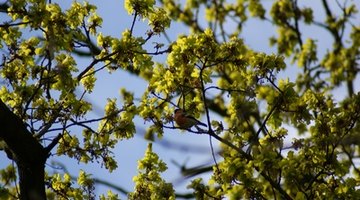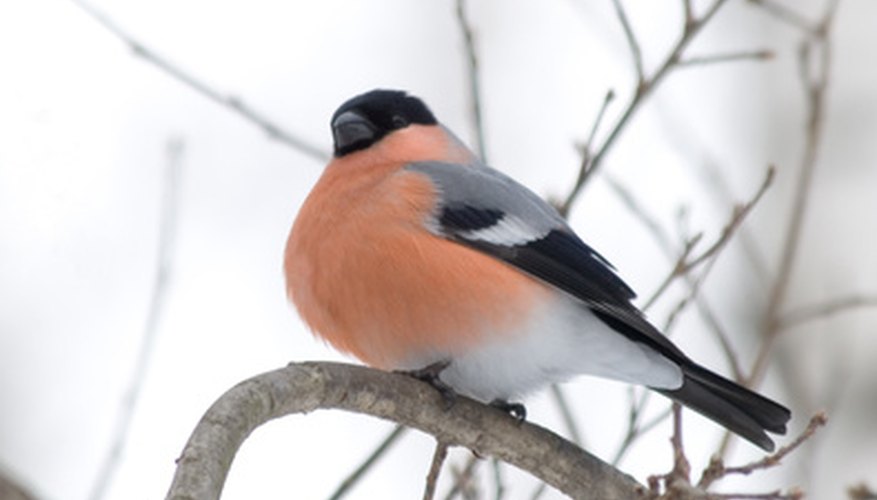A bullfinch is a type of small passerine or perching bird. They are round little birds that are about 6 inches long.
There are seven bullfinch species, but the Eurasian bullfinch is the species commonly bred in captivity and kept as a pet. As with all animals, bullfinches are susceptible to certain diseases. When a pet bullfinch becomes ill, take the bird to an avian veterinarian for diagnosis and a prescribed cure as soon as you notice any symptoms.
Atoxoplasma

Atoxoplasma is sometimes referred to as thick liver disease. This is a protozoal infection caused by a parasite that can be fatal for bullfinches. Young birds between two and nine months of age are especially susceptible.
Infected birds will display sick bird symptoms (SBS): fluffing up its feathers and keeping them fluffed for an unusual length of time, remaining unusually quiet, diarrhoea and weight loss. Neurological problems are present in 20 per cent of atoxoplasma infections, according to Jeffrey R. Jenkins, DVM, of the Avian & Exotic Animal Hospital in San Diego, California. Impaired balance, staggering, walking in circles, collapsing or lying on the floor of the cage and inability to stand are neurological symptoms. To treat this condition, add Sulphachlor-pyrazin to the bird's water for five days in a row each week until the end of moult, when the bird is losing old feathers and getting new ones.
- Atoxoplasma is sometimes referred to as thick liver disease.
- To treat this condition, add Sulphachlor-pyrazin to the bird's water for five days in a row each week until the end of moult, when the bird is losing old feathers and getting new ones.
Good hygiene is the best prevention for this infection.
Paper liners on the bottom of the cage need to be changed daily. Dishes should also be cleaned daily. Cages should be completely cleaned and disinfected once each week.
Pseudotuberculosis

Pseudotuberculosis, or yersinia pseudotuberculosis, is a bacterial infection that bullfinches are susceptible to. There are no specific symptoms for this disease. Generalised sick bird symptoms such as unusual feather fluffing, poor appetite, changes in normal behaviour and remaining unusually quiet can all be indicators. Birds commonly contract this disease during the winter. An avian veterinarian can run a test for the disease. Ampicillin, Amoxicillin and Chloramphenicol are antibiotics commonly given to infected bullfinches as treatment. Good hygiene is the best prevention for this bacterial infection.
- Pseudotuberculosis, or yersinia pseudotuberculosis, is a bacterial infection that bullfinches are susceptible to.
- Ampicillin, Amoxicillin and Chloramphenicol are antibiotics commonly given to infected bullfinches as treatment.
Aspergillosis
Aspergillosis is a fungal infection that can afflict bullfinches. This disease is caused under certain circumstances by exposure to aspergella fumigates, which is a type of mould.
- Aspergillosis is a fungal infection that can afflict bullfinches.
Bullfinches become susceptible to aspergillosis when their immune system is compromised by another illness, unusual stress or malnutrition. Bullfinches captured in the wild and confined in captivity are likely candidates. This is, of course, a very stressful situation for them. Sudden changes in environment, such as being shipped to a pet store for sale and being brought home from the pet store, are very stressful for birds. Breeding also stresses the bullfinch's immune system. This fungal infection can be difficult to detect. Common symptoms are changes in breathing such as gasping and wheezing. A change in the bird's normal vocalisation habits is another common indicator. The treatment varies depending on the bird's condition.
Resolving the stressor that put the bird at risk for the fungal infection is generally the first step.
Further treatment can include systemic or localised antifungal treatment, surgery in cases where the infection is localised, flushing the sinuses and nebulization. Long-term treatment is usually required. As with atoxoplasma and pseudotuberculosis, good hygiene will aid in the prevention of this disease.
